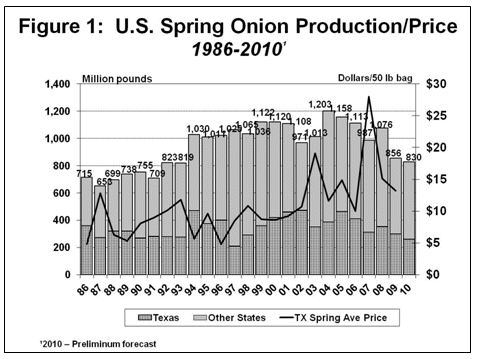Vol. 26, Issue 14, May 4, 2010 – PDF version
Jose G. Peña, Texas AgriLife Extension Economist-Management
The spring onion harvest in Texas opened in mid-April to near record high market prices as reduced carry-in storage onion supplies and significantly weather delayed harvests in Mexico and from the lower Rio Grande Valley of Texas reduced total supplies and created heavy demand driven prices. According to the National Onion Association’s, April 1, 2010 Statistical Report, storage onion supplies on April 1, 2010 at 3.7 million 50 lb bag equivalents, were down 45% from 11.6 million 50 lb bag, equivalents on March 1, 2010 as storage onion supplies filled in the supply deficit from the delayed harvest.
Prices lowered last week as the 3-4 week delayed harvest in the lower Rio Grande Valley of Texas overlapped harvests in the Laredo-Winter Garden region of Texas, Georgia, the Imperial Valley of California and Arizona. The concentration of supplies tended to saturate the market. The estimate of U.S. spring onion production at about 830.2 million pounds is down about 3.0 percent from 855.9 million pounds produced last year. (See Figure 1)
 The volume of spring onion imports from Mexico and Chile are winding down. The current market remains strong, but lower than the near record highs in April as abundant supplies are offered to the market by the overlapping harvests. Yellow jumbos were trading at about $26-$30/50 lb bag last week, but had been trading in April at close to $40-$50/50 lb bag. Prices for yellow mediums were trading for $24-$28/50 lb bag and sweet yellow jumbos were bringing about $40/40 lb. carton. Quality issues as a result of high humidity levels in fields are also having an impact on the market. The industry is expecting prices to remain strong as supplies draw down and spring onion’s shipments taper down.
The volume of spring onion imports from Mexico and Chile are winding down. The current market remains strong, but lower than the near record highs in April as abundant supplies are offered to the market by the overlapping harvests. Yellow jumbos were trading at about $26-$30/50 lb bag last week, but had been trading in April at close to $40-$50/50 lb bag. Prices for yellow mediums were trading for $24-$28/50 lb bag and sweet yellow jumbos were bringing about $40/40 lb. carton. Quality issues as a result of high humidity levels in fields are also having an impact on the market. The industry is expecting prices to remain strong as supplies draw down and spring onion’s shipments taper down.
Acreage Down
The U.S. estimate of spring onion plantings at 28,800 acres is down 1,300 acres (down 4.3%) from last year. The estimate of acreage for harvest at 26,700 acres is down 1.8 percent from last year’s harvest of 27,200 acres. (See Table 1). Note: Acres planted and for harvest in Arizona are estimated as estimates for Arizona from USDA-NASS were discontinued in 2010.
Spring Onion Production in Texas
Spring onion production is decreasing significantly in Texas, especially acres for harvest in the Laredo-Wintergarden region of Texas. Spring onion plantings in Texas are down to record lows from their hay-day in the mid-1930’s when 50,000-80,000 acres were harvested annually. This season, some fields experienced some damage from late winter cold spells and heavy late winter/early spring rains. Some fields are being bypassed in the lower Rio Grande Valley.
Reduced spring onion plantings, lower spring onion acres for harvest, combined with lower average yields this spring of about 610, 50 lb bags/ac compared 660 50 lb bags/ac last year indicates that spring onion production in Texas this spring will approximate 262.3 million pounds, down 12.7 percent from 300.3 million pounds produced last year. This estimate is behind California’s production estimate of 281.8 million pounds. The production estimate for Texas currently accounts for about 31.6 percent of the 830.3 million pound, U.S. spring onion production estimate, compared to 35.1 percent of 2009’s production of 855.9 million pounds.
U.S. Total Onion Production Down
According to USDA-NASS April 1, 2010 Vegetables Report, total planted onion area for all seasons in 2010 is forecast at 154,010 acres, down two percent from last year. Summer non-storage onion planted area, at 18,200 acres, is up 2 percent from a year ago. Total summer onion area, at 125,810 acres, is down one percent from the previous year.
Overall, the spring onion industry remains optimistic about the market outlook.
Appreciation is expressed to Mick Davie, Marketing Specialist, USDA-AMS for his contribution to and review of this article.

